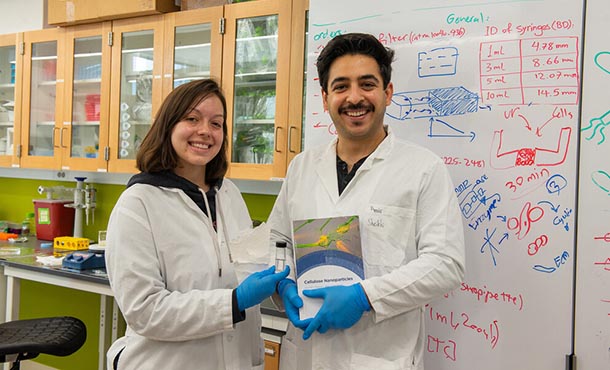
Mica Pitcher, doctoral student of chemistry in the Eberly College of Science, left, and Amir Sheikhi, assistant professor of chemical engineering and biomedical engineering in the College of Engineering, along with other members of Sheikhi's lab, co-authored the first chapters of a two-volume book on cellulose-based nanoparticles. The nonmaterial can be used in a variety of materials, including paper. IMAGE: PENN STATE/KATE MYERS
Engineer pens first chapters of two volumes for Royal Society of Chemistry
8/24/2021
By Ashley J. WennersHerron
UNIVERSITY PARK, Pa. — Cellulose, the main component of plant cell walls, is the most abundant polymer in the world. A carbohydrate made of at least 3,000 glucose molecules, cellulose is used in everything from food and medicine to paper and clothes. Now, according to Amir Sheikhi, assistant professor of chemical engineering and biomedical engineering at Penn State, researchers are developing cellulose-based nanomaterials and applications that may reduce the negative impact of non-sustainable health care products and processes on the environment.
Sheikhi led the composition of two chapters on this topic in a book published by the Royal Society of Chemistry with two volumes: “Cellulose Nanoparticles: Chemistry and Fundamentals” and “Cellulose Nanoparticles: Synthesis and Manufacturing.” The first chapter of the first volume is featured on the book’s cover.
Both chapters focus on hairy cellulose nanocrystals, a newly emerged nanoparticle with chains of cellulose extending from each end. These polymer chains make up the “hairs” of the nanocrystal and offer more functional uses ranging from mechanical reinforcement and bactericidal platforms to water treatment, energy storage and more, according to Sheikhi.
“The hairs impart unique capabilities that are otherwise difficult or often impossible to achieve with conventional nanocelluloses,” Sheikhi said. “Our chapters review the fundamental aspects of the chemistry, structure and properties of hairy cellulose nanocrystals, as well as their potential as a soft matter platform in a plethora of applications in the water-energy-health-food nexus.”
Sheikhi said that the chapters represent not only the latest emerging technology in the field, but also the work of his laboratory at Penn State. The chapters’ co-authors include lab members Joy Muthami, doctoral student in chemical engineering; Patricia Wamea, who graduated from Penn State in 2021 with a master of science in chemical engineering; Mica Pitcher, doctoral student in chemistry in the Eberly College of Science; Zeyu Liu, who graduated from Penn State in 2020 with a bachelor of science in chemical engineering; Sainyam Arora, third-year chemical engineering major; David Kennedy, who graduated from Penn State in 2021 with a bachelor of science in chemical engineering; and Yin-Jen Chang, fourth-year chemical engineering major.
“I hope this work helps clarify the origins and possible applications of hairy cellulose nanocrystals for others interested in the field,” Sheikhi said. “Cellulose and its derivatives are well recognized for their biodegradability, biorenewability and abundance. From use in diagnostics films and hydrogels to medicine and food additives, hairy cellulose nanocrystals hold the potential to positively impact both health care and the environment. We are engineering this platform in our lab to build a more sustainable future.”



